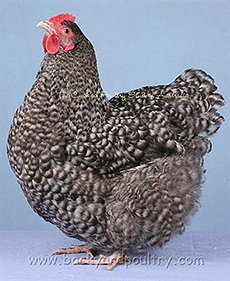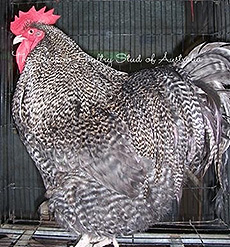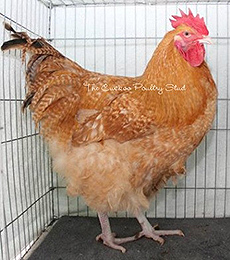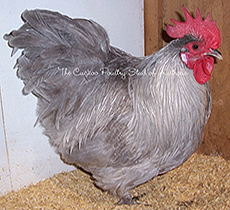Recognising success
Sue Venator is an internationally recognised breeder of large and bantam Orpingtons. Cuckoo Orpingtons are her passion and for this reason she is known as ‘The Cuckoo Breeder’ by many.
Sue is acknowledged as the developer, in both large and bantam size, of the Slate, Lavender and Buff Cuckoo, of the Crele in Gold, Silver and Blue, the Partridge in Gold and Blue, and the large Gold Barred Buff in Australia. With her son, she is the joint developer of the large Blue Cuckoo. She continues to work on new colour forms in both sizes.
Sue has retired to the farm in Victoria, surrounded by her birds and some cattle. This is her story.
When did your interest in poultry start?
I don't think it ever started. I was literally born into the Orpington world. I have always loved having poultry around; I grew up with chooks, geese, turkeys and ducks wandering around the place.
How long has your family been keeping poultry?
My great grand parents emigrated to Australia in the 1800s. Each generation owned poultry of some kind and the family had poultry of some description since coming to Australia, as did most people back then.
What breeds have you and your family kept over the years?
My father had Leghorns for a long time before he acquired his first Black and Cuckoo Orpingtons in 1947 after serving in WWII. He brought these birds back from England. He and my uncle got hold of a group of Orpingtons for 20 pounds sterling - one rooster, two cockerels, five pullets and five hens, all Cuckoo, and a Black pair. They brought the birds back via ship and all birds survived the voyage.
There weren't many Leghorns left when I was born but I do remember them. Mother's family had crossbreds. Mother's mother gave up the crossbreds in favour of the Orpingtons when she saw them.
I have always had my Orpingtons; I also own some Silkies and Phoenix. No matter where I have lived I have dragged my birds along with me.
When was your first show?
Amazingly, owning birds my whole life, my first show as an exhibitor was not until the 2007 National Orpington Show. I had attended a number of shows over the years as a spectator before that.
A cockerel that took out Champion Cuckoo (and went on to be a Multi Year National Champ), was actually a replacement bird as the older cockerel had had his tail feathers seriously damaged only days before the show. His older cousin, a pullet, took out Reserve Champion and another cousin placed second. The replacement cockerel was 15 weeks old the day of the show, but he still earned the following comment on the day from Dallas Smith (then Hon. Secretary of the Orpington Club and a well known authority on the breed): "A massive bird of good depth of colour showing much promise for the continuation of the Cuckoo Orpington in Australia".
2012 was the first year one of my birds won a major award. A Black Bantam pullet was awarded Champion Bantam of Show at the Orpington Northern Feature Show, run in conjunction with The Wyandotte Club Show.
Where did you obtain your stock?
As I mentioned, my family's Cuckoo and first Black Orpingtons came from England. I still have lines that are pure to them. I have been directly involved in caring for and breeding the birds for as long as I can remember.
Some of my other colours were sourced from top Australian bloodlines. I acquired my first large Blues just over 20 years ago, my very first Blue passed away in her sleep aged 20 years old, two years ago, and my first Splash, the Blue's younger sister, passed away aged 17-and-a-half years not long after. From 2012 I no longer work with the large Blue and only have a few large Splash as pensioners.
I got my first large Whites on Christmas Day 2008 and my first actual large Buff pen in July 2009 (I have owned the odd single Buff before that). I also acquired large Blacks from Australian lines. These colours were sourced from a number of quality lines including Blatch, Vizer, Beven, Edwards, Wilkinson, Flint, Stannard and Tiyce. I no longer work with the large Whites and have passed them on to a friend who has a passion for them.
I currently have all colours in bantam, including my latest projects which are the Lavender, Lavender Cuckoo, Crele and Partridge. These and several other colours in Cuckoo including a new line of the bantamised form of the APS listed Cuckoo were "made" by me; the Black, White, Buff and Blue bantam colours were sourced from D. Smith, R. Callinan, E. & W. Coffee, S. Spiker and C. Tiyce. The Cuckoo (several colours) and Crele/Partridge bantams were "made" by me; the standard bantam colours were sourced from D. Smith, R. Callinan, E. & W. Coffee, S. Spiker and C. Tiyce.
However over the next few years I will be focusing on select colours only in both sizes, as others are now showing an interest in these newer colours.
Did you have any mentors in your early years?
I would have to say that my whole family, Aunts, Uncles. Both Gran and Great Gran as well as my Dad were the main influences with regard to the birds when I was growing up. It didn';t matter whose place we were at, there were birds and lots of bird talk.
In regards to breeding nice birds and exhibition, Dallas Smith, Simon Beven, Rob Callinan and my dear friend Lance Hicks (late of Benalla) would be the names foremost in my mind when the word mentor is used.
It was with their support that I felt confident enough to develop several new colours, including the new colours in the Cuckoo, in both sizes. And I surprised everyone a number of years ago now with my Cuckoo Silkies.
How do Orpingtons of today compare with those of earlier eras?
These days Orpingtons are a bit prettier on the eye than the originals. However I believe they are slowly being turned into show ponies and we are going to lose the original dual purpose intent of the breed if we don't go back to basics and ensure that they not only look good but are good egg and meat suppliers.
To those that have owned the original type Orpingtons they have their own charm. And many of these owners do still have a line or two that still resembles those early birds to some extent, myself included.
I don't believe that the breed has reached its peak potential yet and that it won't until we have a happy medium of a beautiful bird that can consistently supply good numbers of eggs and an abundance of meat.
How do the 'original type Orpingtons' compare physically with today's show fowls?
The Orpington is one of the largest breeds in Australia. They are a well-feathered bird that gives a bold, graceful appearance with a neat small head compared to the body, with bright large eyes. They need to display a deep broad chest that flows to a rounded appearance in the under-carriage, and a stately rise to the tail from a wide full rump.
Recently the description for the under-carriage was stated to "look like a cricket ball in roundness, only larger"—I use the term 'bowling ball'. The thighs should be almost covered by the body feathers with the feet visible.
The main difference visually in the original and modern is that the original Orpingtons were a less profusely feathered bird—they were very well-feathered and gave a good rounded appearance but were not 'powder puffs' like some we see today that have copious amounts of 'fluff' in the rear.
This modern look not only distorts the current standard by allowing feathers and fluff to cover the feet (the feet should be visible) but it is starting to affect the natural breeding ability in some (but not all) lines due to profuse feathering around the rear end. All the feathers and fluff make for a pretty bird visually (albeit slightly non standard) but also makes for the need to trim back the feathers each breeding season in the affected lines, or use artificial insemination for good fertility.
I prefer the birds to look like a happy medium between the original and the modern standard. I have bred my birds to retain the good layers reputation and also for their meat.
How long do you keep birds for before making a decision about their future?
I tell everyone that because Orpingtons take about two years to fully grow out I do not recommend a final decision until at least 9-11 months, preferably a bit older (12 to 14 or 15 months). By then even the still-in-training eye can tell a good bird from a bad one.
I do advise to cull every month or so as they are growing for defects. This is how I end up with the birds I keep, and identify those I re-house to people starting out in the breed and those I give to friends.
I have known people that have re-housed birds that have grown out to be the best they have ever bred and when seeing the bird as an adult have regretted the decision to re-house too young. You only make that mistake once then you do grow everything out properly first.
What attracts you to Orpingtons?
I could say I keep them because in my opinion they are the best breed in the world and I have said this on occasion when asked!
But seriously, I find them more pleasing than most breeds not only for looks but temperament. Yes, there are other breeds out there that compare admirably but I can't look past an Orpington. They say "Love is blind" but in the case of the Orpington it isn't. They are beautiful and worth loving. Now I know that sounds like sentimental slop but that is how I feel, my heart melts each time I see a good Orpington. Just ask anyone in The Club, they can tell you I have a huge soft spot for the breed.
Or perhaps it was because I imprinted on them at an early age? Who really knows - either way I think they are wonderful.
What are the main challenges in breeding Orpingtons?
The main challenge is keeping them breeding like the dual-purpose breed that Mr Cook originally intended. They were 'made' to be an attractive bird that is a good egg layer and has the ability to also be 'Sunday dinner' with an abundance of flesh that is tender and flavoursome.
Note that the Cuckoo, developed by Mr Cook's daughter Elizabeth, was developed to be a good Winter layer, and to this day all my Cuckoos lay best through late Autumn, Winter and the first few weeks of Spring when it is still cold.
What advice do you have for anyone developing a new colour in a breed?
Word number one: records. Keep accurate and detailed records, written and photographic.
Word number two: patience and then some more patience. So many just want the colours 'yesterday' and tend to try to rush the process, and then get angry when things go wrong. Of course things will go wrong - that is part of the process. Hence the need for patience.
Be aware of how to pick the recessive birds as these are some of your most valuable 'weapons' in development (at least I think so). Hence again the need for patience and careful selection of each generation's parents.
Another and possibly the most important advice after records and patience is - never use a pullet, always use hens only as the parent females. Carefully examine each potential next generation breeder, ensuring they have no defects and are of the best Type possible.
Try to always keep the type (for any breed) the foremost concern when developing a new colour. If the bird doesn't LOOK like an Orpington (or a Hamburgh or Sultan etc), then it isn't an Orpington (etc). Be very aware that it can take several years (in some cases 10 or more years) until the development for the colour is complete or at least to a stage where it can be exhibited and easily recognised for the breed in question. A case in point – with my Crele (note that in Orpingtons it is spelt Crele) the first exhibited were generation 10 and even then the Silver Crele cockerel left something to be desired regarding type and colour and was only there to show the colour. His offspring display the type and silver colour much better.
I believe it is important to have related/semi related birds so you pretty much know what you will get. When bringing in new/unrelated stock you need to test breed, not just throw them in the pen and expect the offspring to be as good as what you already have.
When it comes to breeding birds I quote my friend Lance and say: "Breed the best to the best and hope for the best. Keep the best and cull the rest. Don't feed what you don't need".
And I say to listen to what the "old-timers" are saying as they really do know their stuff. They rarely if ever studied genetics but can almost always supply excellent birds. They know just by what they have bred and by looking at each individual bird which ones need to go together. To learn that skill you need to stop, listen and actually pay attention.
One also needs to remember that the person that did the hard yards is the developer, and to be respectful of, and acknowledge that person's work. I am pleased to say that a small number of others have been working with the Crele and Partridge Orpington for the last year or so and are helping develop them even further as to colour and type.
What methods do you use to get your birds ready for a show?
Spend time each day talking to and handling your birds so they are complacent about being in a small pen, all the noise and being handled. Be sure to clean each bird well so they present at their best on the day.
Make sure they are transported so they are not overly stressed by the experience – some get their birds used to being handled but forget to get them used to being in a transport container and being in a moving car. Get them used to being put in their containers and being taken on short 5 or 10 minute trips every few days the week or so leading up to the show.
I think this is very important as I have had two birds in the last five years that have suffered travel sickness, so by taking them on short trips you not only get them used to travelling you should also be able to find out before the big trip if they suffer or not.
Feeding your fowls – can you give some advice?
I recommend that everyone gives their birds the best feed they can. I start mine on good quality starter and grower. When they are on adult feed they get a mix of whole and crushed grains, pellets and what I call the 3 Gs: grass, greens and grubs. I don’t over technicalise feeding the birds; I just give them a good variety for good health.
What advice would you give about obtaining stock?
Always, always get your stock from a reputable well known breeder. Contact the breed club of your chosen breed; they can give you names of breeders that live not only near you but interstate as well. They can usually advise which are the most reputable and of any show reputation their birds have.
Also contact your local poultry club and get as much information as possible about the local breeders. Often the local club is the best for breeders in your area as they usually know the people personally.
And finally: there is no such thing as a "dumb question" the only silly question is the one not asked, because if you don't ask you won't know.
What are your concerns about purebred poultry in the future?
My main concern is that so few juniors are coming into the arena. Without them there is no future. I always try to encourage not just the junior but their parents as well. After all, it is the parents that will be getting the feed and driving to and from shows etc until the junior gets a job and a licence/car to do it all themselves.






